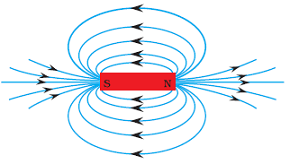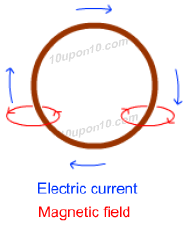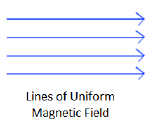Magnetic Effects of Electric Current - Class 10th Science
NCERT InText Solution
Question: 1. Why does a compass needle get deflected when brought near a bar magnet?
Answer: A compass needle is also a magnet. When two magnets are brought closer, there is repulsion between same poles of magnets and attraction between opposite poles. This happens because of magnetic field produces by a magnet.
Thus, when a compass needle is brought near a bar magnet, the magnetic field produce by bar magnet deflects the compass needle.
Question: 2. Draw magnetic field lines around a bar magnet.
Answer:

Question: 3. List the properties of magnetic lines of force.
Answer: The properties of magnetic field lines are as follows:
Magnetic field moves from the north pole of a magnet towards the south pole of the magnet. Magnetic field lines are always arranged in the form of concentric circles pattern. No two field lines cross each other. The proximity of the field lines shows the relative strength of the magnetic field. Magnetic field lines are closer near the poles and become farther from each other around the centre of the magnet.Question: 4. Why don't two magnetic lines of force intersect each other?
Answer: If two magnetic lines cross each other, this means that the compass needle would point in two directions at the point where the lines would have crossed each other but this is not possible in the real world.
That 's why two magnetic lines of force don' t intersect each other.
Question: 5. Consider a circular loop of wire lying in the plane of the table. Let the current pass through the loop clockwise. Apply the right hand rule to find out the direction of the magnetic field inside and outside the loop.
Answer: Right Hand Rule states that if the thumb is pointing in the direction of flow of current and other fingers are wrapped around the conductor to show the direction of magnetic field. The magnetic field would be in anti-clockwise direction when observed from the direction from where the current is moving ahead.
This means that when electric current is passed through a circular loop lying in the plane of the table, the magnetic field would be towards the table when it is inside the loop and towards the viewer when it is outside the loop. This can be shown by the following figure.

The blue arrows show the direction of current and the red arrows show the direction of magnetic field.
Question: 6. The magnetic field in a given region is uniform. Draw a diagram to represent it.
Answer: Given diagram shows the uniform magnetic field in the given region.

Question: 7. Choose the correct option.
The magnetic field inside a long straight solenoid-carrying current
(a) Is zero.
(b) Decreases as we move towards its end.
(c) Increases as we move towards its end.
(d) Is the same at all points.
Answer: (d) Is the same at all points.
Question: 8. Which of the following property of a proton can change while it moves freely in a magnetic field? (There may be more than one correct answer)
(a) Mass
(b) Speed
(c) Velocity
(d) Momentum
Answer: (c) and (d), i.e. velocity and mass of proton change when it enters a magnetic field. When a proton enters a magnetic field it starts moving on a circular path and thus attains angular momentum.
Question: 9. In Activity 13.7, how do we think the displacement of rod AB will be affected if (i) current in rod AB is increased; (ii) a stronger horse-shoe magnet is used; and (iii) length of the rod AB is increased?
Answer: When a current-carrying conductor is placed in a magnetic field, it experiences displacement. The displacement varies directly as the strength of current, strength of magnetic field and length of the conductor. Hence, in all the three conditions mentioned in this question; the displacement of conductor would increase. This means
(i) If current in rod AB is increased, the displacement of rod AB will increase
(ii) If a stronger horse-shoe magnet is used, the displacement of rod AB will increase
(iii) If length of the rod AB is increased, the displacement of rod AB will increase
Question: 10. A positively-charged particle (alpha-particle) projected towards west is deflected towards north by a magnetic field. The direction of magnetic field is
(a) Towards south
(b) Towards east
(c) Downward
(d) Upward
Answer: According to Fleming's Left Hand rule; if the thumb, the forefinger and the middle finger of the left hand are in mutually perpendicular; the thumb shows the direction of motion, the index finger shows the direction of magnetic field and the middle finger shows the direction of current. Thus, the direction in which the alpha-particle is moving would be same as the direction of current. The direction of magnetic field would towards north, i.e. upward. Since alpha-particle is deflected towards north so it means that the direction of magnetic field is towards north, i.e. upwards.
Thus, Option (d) Upward is the correct answer
Question: 11. State Fleming’s Left Hand Rule.
Answer: Fleming's Left Hand rule states that if the thumb, the forefinger and the middle finger of the left hand are in mutually perpendicular; the thumb shows the direction of motion, the index finger shows the direction of magnetic field and the middle finger shows the direction of current.
Question: 12. What is the principle of an electric motor?
Answer: Principle of Electric Motor: The electric motor works on the principle of electromagnetism. When a rectangular coil is placed in a magnetic field and current flows through it; a force begins to act on the coil which results in rotational movement of the coil.
Question: 13. What is the role of a split ring in an electric motor?
Answer: In an electric motor, the direction of the coil gets reversed after every half rotation. To prevent this, a split ring is used. It reverses the direction of the current through the coil after every half turn. Due to this, the arm of the coil which was earlier pushed down is pushed up; after half rotation. This leads to a continuous rotation of coil in one direction only.
Question: 14. Explain different ways to induce current in a coil.
Answer: There can be following ways to induce current in a coil:
(a) The coil should be moved in a magnetic field.
(b) The coil can be kept in static and the magnet should be moved in relation to it.
Question: 15. State the principle of an electric generator.
Answer: The electric generator works on the principle of electromagnetic induction. It states that when a coil is moved in a magnetic field; a current is induced in the coil. In case of electric generator; large number of turns in coil and strong magnetic field are used to produce strong current.
Question: 16. Name some sources of direct current.
Answer: Electrochemical cell and DC generator are some of the sources of direct current.
Question: 17. Which sources produce alternating current?
Answer: AC generators produce alternating current. Power stations in India produce alternating current.
Question: 18. Choose the correct option.
A rectangular coil of copper wires is rotated in a magnetic field. The direction of the induced current changes once in each
(a) two revolutions
(b) one revolution
(c) half revolution
(d) one-fourth revolution
Answer: (c) Half revolution
Question: 19. Name two safety measures commonly used in electric circuits and appliances.
Answer: (a) Use of earth wire. Earth wire earth extra current, if any flows to the body of electrical appliances.
(b) Electric fuse. Use of electric fuse ensures break in circuit of electric current, in the case of short circuit or overlod and prevent burning up of electrical applicances and any accident.
Question: 20. An electric oven of 2 kW is operated in a domestic electric circuit (220 V) that has a current rating of 5 A. What results do you expect? Explain.
Answer: The current drawn by the electric oven can be calculated using following relation:

Here, Given P = 2 kW = 2000 W and V = 220 V

Question: 21. What precaution should be taken to avoid the overloading of domestic electric circuits?
Answer: Following precautions should be taken to avoid overloading of domestic electric circuit:
(a) Do not use too many appliances in a single line, i.e. from a single output socket.
(b) Do not use too many appliances simultaneously in the circuit.
(c) Faulty appliances should be immediately repaired or replaced.
(d) Electric fuse of proper rating should be used.